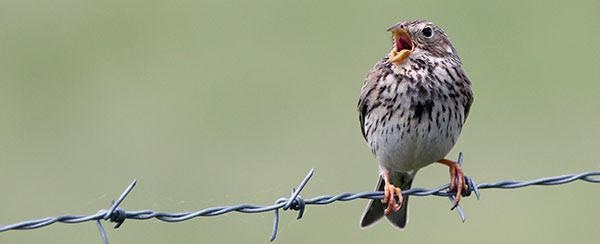Unbelievable declines in bird populations are taking place around the world. This was concluded by a study performed by researchers at multiple institutions.
 Corn Bunting, a grassland species found throughout Europe. Image Credit: Alex Lees.
Corn Bunting, a grassland species found throughout Europe. Image Credit: Alex Lees.
The study has recently been reported in the Annual Review of Environment and Resources journal.
The decline and loss of natural habitats and direct overexploitation of several species are quoted as the primary threats to avian biodiversity. Climate change has been found to be a developing driver of the decline in bird populations.
We are now witnessing the first signs of a new wave of extinctions of continentally distributed bird species avian diversity peaks globally in the tropics and it is there that we also find the highest number of threatened species.
Alexander Lees, Study Lead Author and Senior Lecturer, Manchester Metropolitan University
Alexander Lees is also a research associate at the Cornell Lab of Ornithology.
The study states that around 48% of present bird species throughout the world are known or presumed to be experiencing population declines. Populations are known to be stable for 39% of species and only 6% are displaying growing population trends, and the status of 7% is yet to be discovered.
The authors of the study reviewed alterations in avian biodiversity with the help of data obtained from the International Union for Conservation of Nature’s “Red List” to disclose population variations among the world’s 11,000 bird species.
The outcomes of the study reflect the results of a seminal 2019 study which helped identify that almost 3 billion breeding birds have been lost during the past five decades throughout Canada and the United States. The lead author of that research is also an author of this global status report.
After documenting the loss of nearly 3 billion birds in North America alone, it was dismaying to see the same patterns of population declines and extinction occurring globally because birds are highly visible and sensitive indicators of environmental health, we know their loss signals a much wider loss of biodiversity and threats to human health and well-being.
Ken Rosenberg, Conservation Scientist, Cornell Lab of Ornithology, Cornell University
Rosenberg is currently retired.
Despite their observations, the study authors state that there is a belief in avian conservation measures. However, transformative change is required.
The fate of bird populations is strongly dependent on stopping the loss and degradation of habitats that is often driven by demand for resources. we need to better consider how commodity flows can contribute to biodiversity loss and try to reduce the human footprint on the natural world.
Alexander Lees, Study Lead Author and Senior Lecturer, Manchester Metropolitan University
Rosenberg stated, “Fortunately, the global network of bird conservation organizations taking part in this study have the tools to prevent further loss of bird species and abundance, from land protection to policies supporting sustainable resource-use, it all depends on the will of governments and of society to live side by side with nature on our shared planet.”
Information is vital, and the study authors stress that the growth of public participation in bird monitoring and the advent of user-friendly tools, like the Cornell Lab’s ebird database, make continental-scale breeding bird surveys, distribution atlases, and plenty of models possible and help inform conservation measures.
The current research was carried out by researchers from Manchester Metropolitan University, the Cornell Lab of Ornithology, BirdLife International, the University of Johannesburg, Pontifical Xavierian University, and the Nature Conservation Foundation.
Journal Reference:
Lees, A. C., et al. (2022) State of the World’s Birds. Annual Review of Environment and Resources. doi.org/10.1146/annurev-environ-112420-014642